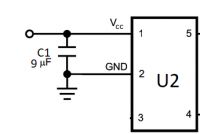Good morning,
I own several Philips Sonicare toothbrushes for personal use.
Unfortunately, in two brushes with markings HX6930 / HX6910 there is a problem with too low intensity (also frequency) of vibration. As one of them vibrates a little stronger, and the other weaker, I was able to identify the cause of the weak vibration by exchanging integrated circuits between these units.
To make it clear what I'm talking about below, I put a pcb picture of two brushes:

Blue PCB - HX6930 / HX6910 series I have two broken copies, hardly used so they had to break quickly,
Q1 is TSC6963SD
Q2 is tsc 6866s
U1 TO MIcrochip PIC16F726
U2 is b13U but I met here with b10m and b1c1 housing is SOT-23-5
Green PCB - the older series without U2 the brush works, present here for comparison in the hope that after understanding its operation and the sense of adding U2 you will be able to bypass U2 somehow,
Q1 is TSC6189D
U1 is cy8c27443
I don't know Q2 today
Symptoms that I was able to identify in bad vibration brushes:
- the more it breaks (vibrates less intensively), the more the Q2 heats up
- U2 replacement between brushes causes a change of symptoms (the one that vibrated weakly and heats up very much Q2 vibrates more strongly and heats Q2 less well, and vice versa), therefore I suspect that the integrated circuit marked U2 is broken.
I suspect U2 is a dc-dc converter, maybe something from the family B118 but only inferences and casing availability
SOT-23-5.
It is worth adding that part of the diagram found here
matches the brush connections.

I am asking for help in repairing this brush.
helpful will be suggestions on what to replace or how to bypass U2, and how to meter determine what is the system with the designation U2
Some information on the general construction of the sonicare brushes can be found here and here
Thank you in advance
I own several Philips Sonicare toothbrushes for personal use.
Unfortunately, in two brushes with markings HX6930 / HX6910 there is a problem with too low intensity (also frequency) of vibration. As one of them vibrates a little stronger, and the other weaker, I was able to identify the cause of the weak vibration by exchanging integrated circuits between these units.
To make it clear what I'm talking about below, I put a pcb picture of two brushes:

Blue PCB - HX6930 / HX6910 series I have two broken copies, hardly used so they had to break quickly,
Q1 is TSC6963SD
Q2 is tsc 6866s
U1 TO MIcrochip PIC16F726
U2 is b13U but I met here with b10m and b1c1 housing is SOT-23-5
Green PCB - the older series without U2 the brush works, present here for comparison in the hope that after understanding its operation and the sense of adding U2 you will be able to bypass U2 somehow,
Q1 is TSC6189D
U1 is cy8c27443
I don't know Q2 today
Symptoms that I was able to identify in bad vibration brushes:
- the more it breaks (vibrates less intensively), the more the Q2 heats up
- U2 replacement between brushes causes a change of symptoms (the one that vibrated weakly and heats up very much Q2 vibrates more strongly and heats Q2 less well, and vice versa), therefore I suspect that the integrated circuit marked U2 is broken.
I suspect U2 is a dc-dc converter, maybe something from the family B118 but only inferences and casing availability
SOT-23-5.
It is worth adding that part of the diagram found here
matches the brush connections.

I am asking for help in repairing this brush.
helpful will be suggestions on what to replace or how to bypass U2, and how to meter determine what is the system with the designation U2
Some information on the general construction of the sonicare brushes can be found here and here
Thank you in advance


